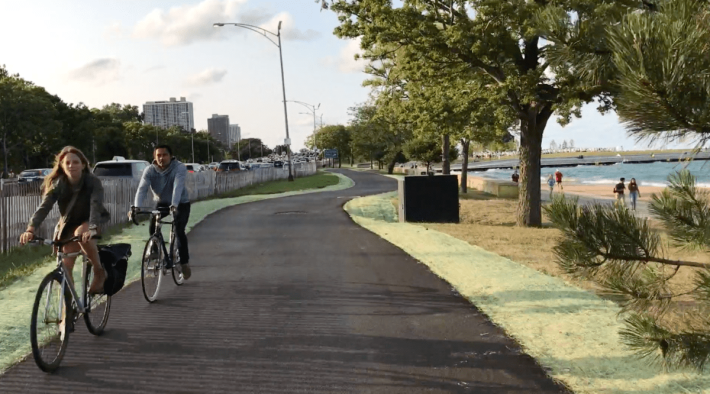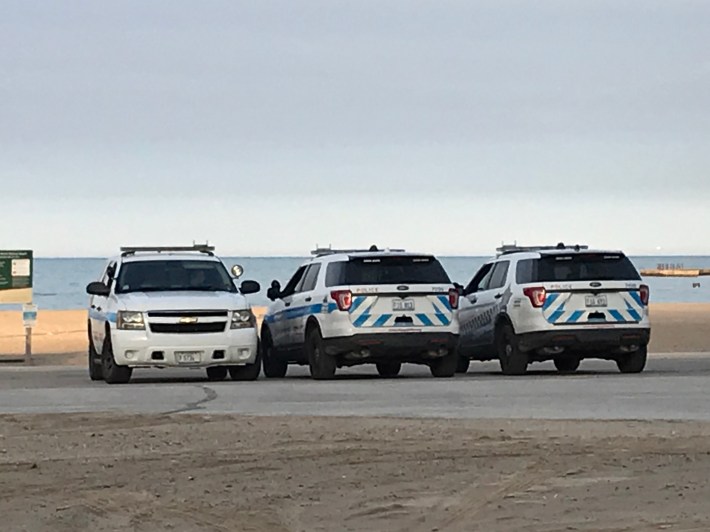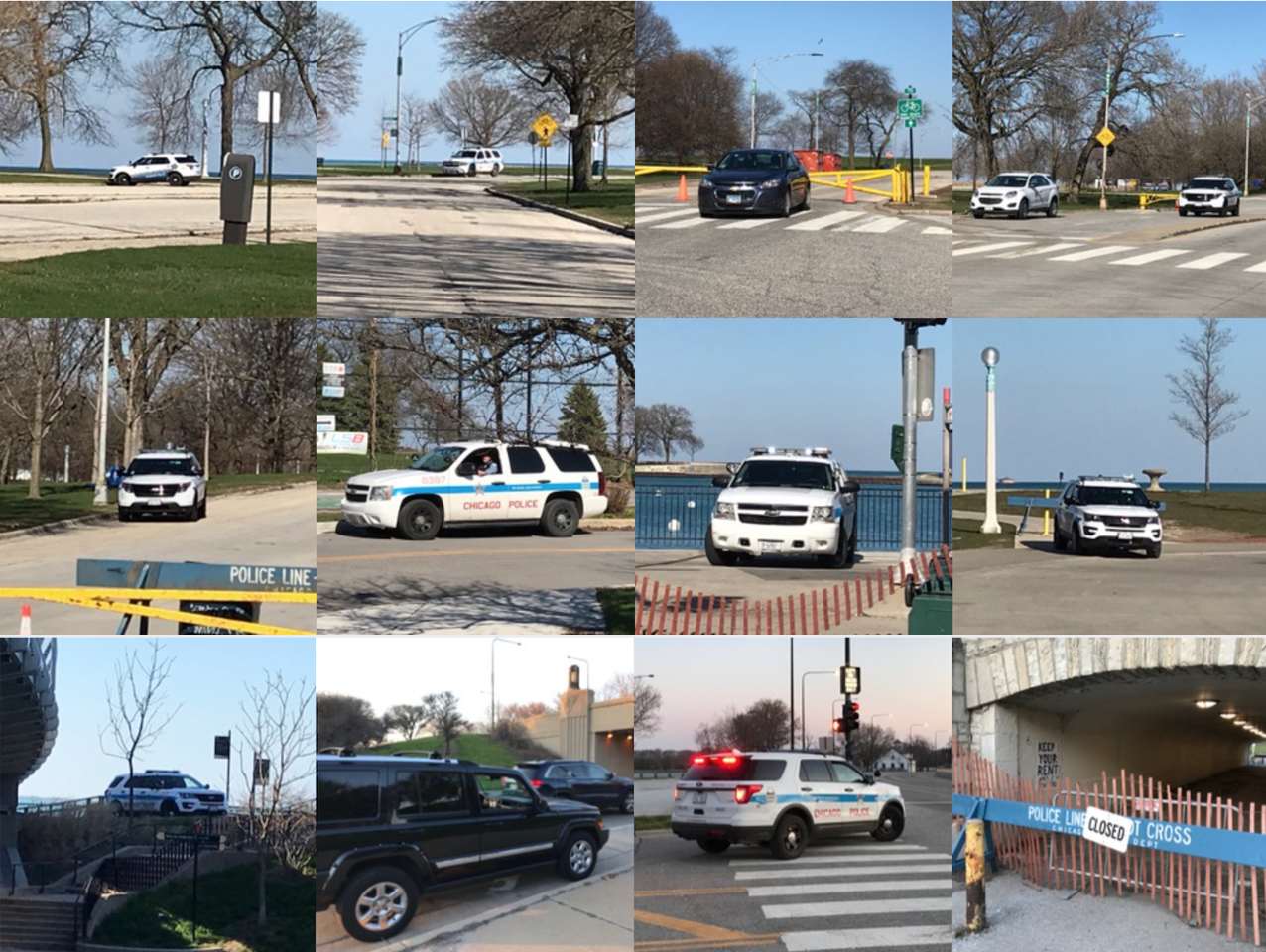On Saturday I took advantage of the lovely weather to check out conditions along the entire length of the Low-Stress Lakefront Pandemic Cycling Route. Streetsblog Chicago published this on-street alternative to the 18.5-mile Lakefront Trail commuting corridor after Mayor Lori Lightfoot closed all of the city's lakefront parks on March 26. Lightfoot announced the closures the day after many residents came out to the shoreline in nice weather, and some of them disobeyed social-distancing guidelines by congregating in large groups, playing team sports, and using playground equipment.
In the wake of that decision, Kyle Lucas, an essential worker with HIV who can't risk viral exposure on transit, launched a petition asking the mayor to reopen the Lakefront Trail for cycling, which is currently closing in on 1,000 signatures. Supporters include a number of healthcare workers who say the elimination of Chicago's most important car-free bikeway has messed up their commutes, in some cases causing them to switch to driving. So far, Lightfoot has indicated that reopening the trail during COVID-19 is a non-starter.
But if at some point there's enough political support to overturn the total ban on Lakefront Trail use, there are a couple different scenarios for how a bikes-only policy could work. We could issue high-visibility badges that essential workers like Lucas could display to let police officers guarding the lakefront know they're authorized to ride.

However, it would be much easier, with a lot less bureaucracy, to simply allow all cyclists, including recreational riders, to use Lakefront Trail. (Granted, I have heard from some marathoners and ultramarathoners who aren't happy about that idea.) Since cyclists would be able to use both the bike-only and pedestrian-only paths, there would be plenty of room for social distancing. Enforcement would work like it does during non-pandemic times. Between 11 p.m. and 6 p.m., when the shoreline parks are closed, if you're hanging out the police will order you to leave, but if you're riding a bike they allow you to proceed.
"But wouldn't enforcing the bikes-only rule divert police resources that are sorely needed during the crisis?" you might ask. Not anymore than are currently being diverted by lakefront duty. At it stands, it appears that most of those officers have little to do but chat with each other and enjoy the nice lake views, which surely makes this the second-sweetest Chicago policing gig, right behind doing traffic control for the World Naked Bike Ride. The bikes-only policy would simply require the officers who are already on the lakefront to do some actual police work.

But just how many cops are currently patrolling the shoreline by the Lakefront Trail? The department wouldn't say. "Out of an abundance of caution and safety... we cannot comment on the specifics of policing strategy, including deployment numbers," a spokesperson told us last week.
So during my ride Saturday, I stopped by just about all the major street entrances to the Lakefront Trail to count squad cars. Here's what I saw during my journey, which started around 4 p.m. at Ardmore Avenue and ended around 7:30 p.m. at 71st Street.
- Ardmore: No police
- Bryn Mawr: No police
- Foster: 2 squad cars
- Lawrence: 1 unmarked car, possibly Chicago Park District security
- Wilson: 1 squad car and 1 unmarked car, possibly Chicago Park District security
- Montrose: 1 squad car
- Irving Park: 1 squad car
- Belmont: 1 squad car
- Fullerton: 1 squad car
- North: No security presence
- Grand: 1 squad car
- Monroe: No security presence
- Jackson: No security presence
- Balbo: No security presence
- 31st: No security presence
- 35th: No security presence
- Oakwood: No security presence
- 47th: Unmarked car, guy in reflective vest says he's "working for the police"
- 51: No security presence
- 55: No security presence
- Hayes (63rd): 1 squad car
- 67th: No security presence
- 71st: Unmarked car parked by South Shore Cultural Center
So that comes to nine squad cars, plus three or four other vehicles likely there for security. Of course, this doesn't include officers stationed at other lakefront parks north and south of the Lakefront Trail.
Interestingly, on this whole 18.5-mile stretch there was only one more squad car than I saw stationed on the 3.5-mile segment between Foster and Fullerton when I stopped by late Thursday afternoon in chilly weather, and almost all of the squad cars I saw Saturday were in that same short stretch. I also saw squad cars parked at many of those North Side locations during a late-night ride I took a couple weeks ago.
The takeaway seems to be that the CPD is focusing lakefront policing on the North Side, with a lot less attention paid to the South Side. (South Siders, please chime in in the comments section if you've noticed otherwise since the lakefront ban started.) That makes some sense, because the north lakefront neighborhoods are generally denser than their southern counterparts, with a greater number of people of people using the trail and the shoreline, and therefore more potential for dangerous crowding during the pandemic. Likewise, if a bikes-only policy is implemented on the Lakefront Trail in the future, the bulk of the enforcement will be needed on the most crowded stretches of the shoreline, particularly between the Loop and Irving Park Road. Therefore, the distribution of cops probably wouldn't need to change much.
Here are some tips on preventing the spread of COVID-19, and advice for Chicagoans on what to do if you think you may have been exposed to the virus.





